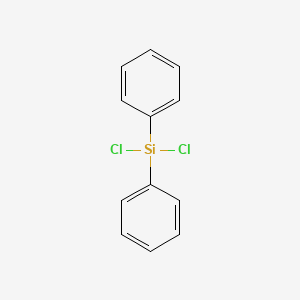D0877 | dichlorodiphenylsilane
| Toxicity | Dose | Time | Species | Model | Method | Action | Positive criterion | Reference |
|---|---|---|---|---|---|---|---|---|
| MEMBRANE POTENTIAL | 12.96±9.66 | human | qHTS-HepG2 | MMP assay | decrease | IC50 | 163 | |
| MEMBRANE POTENTIAL | 22.39 | human | HepG2 | MMP assay | decrease | IC50 | 163 | |
| MEMBRANE POTENTIAL | rat | hepatocytes | MMP assay | Negative | IC50 | 163 | ||
| Pictogram | Signal | Statements | Precautionary Statement Codes |
|---|---|---|---|
   |
Danger |
Aggregated GHS information provided by 591 companies from 13 notifications to the ECHA C&L Inventory. Each notification may be associated with multiple companies. Reported as not meeting GHS hazard criteria by 442 of 591 companies. For more detailed information, please visit ECHA C&L website Of the 12 notification(s) provided by 149 of 591 companies with hazard statement code(s): H310 (26.85%): Fatal in contact with skin [Danger Acute toxicity, dermal] H314 (100%): Causes severe skin burns and eye damage [Danger Skin corrosion/irritation] H411 (61.74%): Toxic to aquatic life with long lasting effects [Hazardous to the aquatic environment, long-term hazard] Information may vary between notifications depending on impurities, additives, and other factors. The percentage value in parenthesis indicates the notified classification ratio from companies that provide hazard codes. Only hazard codes with percentage values above 10% are shown. |
P260, P262, P264, P270, P273, P280, P301+P330+P331, P302+P350, P303+P361+P353, P304+P340, P305+P351+P338, P310, P321, P322, P361, P363, P391, P405, and P501; (The corresponding statement to each P-code can be found at the GHS Classification page.) |
   |
Danger |
H310: Fatal in contact with skin [Danger Acute toxicity, dermal] H314: Causes severe skin burns and eye damage [Danger Skin corrosion/irritation] H318: Causes serious eye damage [Danger Serious eye damage/eye irritation] H371: May cause damage to organs [Warning Specific target organ toxicity, single exposure] |
P260, P262, P264, P270, P280, P301+P330+P331, P302+P350, P303+P361+P353, P304+P340, P305+P351+P338, P309+P311, P310, P321, P322, P361, P363, P405, and P501; (The corresponding statement to each P-code can be found at the GHS Classification page.) |
| 08811ZE689 | 4-16-00-01526 (Beilstein Handbook Reference) | 80-10-4 |
| ACMC-20977f | AI3-51461 | AKOS008901314 |
| ANW-13609 | BRN 0609882 | Benzene, 1,1'-(dichlorosilylene)bis- |
| C-27529 | C12H10Cl2Si | CAS-80-10-4 |
| CC-26543 | CD5950 | CHEMBL2144653 |
| D0362 | DB-029647 | DICHLORODIPHENYLSILANE |
| DSSTox_CID_6494 | DSSTox_GSID_26494 | DSSTox_RID_78122 |
| DTXSID2026494 | Dichlor-difenylsilan | Dichlor-difenylsilan [Czech] |
| Dichloro(diphenyl)silane | Dichlorodiphenylsilane, 97% | Dichlorophenylsilane, 97%, AcroSeal(R) |
| Diphenyl dichlorosilane | Diphenyldichlorosilane | Diphenyldichlorosilane [UN1769] [Corrosive] |
| Diphenyldichlorosilane [UN1769] [Corrosive] | Diphenylsilicon dichloride | Diphenylsilyl dichloride |
| EC 201-251-0 | EINECS 201-251-0 | FT-0625257 |
| HSDB 316 | InChI=1/C12H10Cl2Si/c13-15(14,11-7-3-1-4-8-11)12-9-5-2-6-10-12/h1-10; | KSC106K8H |
| LS-145169 | M267 | MCULE-1550969444 |
| MFCD00000489 | NCGC00163994-01 | NCGC00260101-01 |
| NSC 77110 | NSC-77110 | NSC77110 |
| OSXYHAQZDCICNX-UHFFFAOYSA-N | Q27236382 | RTR-030944 |
| SCHEMBL76000 | ST2412796 | Silane, dichloro-diphenyl- |
| Silane, dichlorodiphenyl- | TR-030944 | TSL 8062 |
| Tox21_202552 | UN 1769 | UN1769 |
| UNII-08811ZE689 | WLN: G-SI-GR&R | ZINC169743011 |
| dichloro-diphenyl-silane | dichlorodiphenylsilicane | diphenyl dichlorosilicane |
| diphenyl dichlorosilicate |
| CAS Number | 28630-33-3, 80-10-4 |
| PubChem Compound | 6627 |

